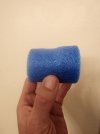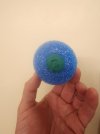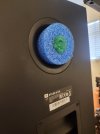firestart3r
Member
- Joined
- Aug 17, 2021
- Messages
- 45
- Likes
- 13
Hello all,
Newbie here...
I would like to add a subwoofer to my stereo system to have a bit more punch when listening to movies. My question is concerning subwoofer integration with my integrated amplifier.
I was thinking to try a subwoofer "the easy way" without buying a miniDSP flex + microphone... to try and see if I like the sound in my room.
Also, my other objective is to diminish the costs of making this "sound experiment".
For that, I was looking at my bookshelf speakers spinorama to try to determine at what crossover frequency to set on the subwoofer.
My understanding is that looking at the speakers slope, I could calculate a "starting point" for the subwoofer's low pass filter crossover frequency ? Is that a good approach ?
If yes, can you guys tell me how to calculate the slope on the PSB P5 ? Im a bit confused...
Is it a -14 db / -21db slope ? -7 db / -22.5 db slope ?
100hz = +1 db
80hz = +1 db
50hz = -6 db
40hz = -13 db
25 hz = -28.5 db
20hz = -34 db
What slope should I look for when shopping for subwoofers for the speaker to "naturally" match the speaker's slope ? Is it possible to find the slope of the subwoofer without taking measurements ? Maybe the manufacturer can give me that information or I could use a spinorama data for the sub if I find it online ?
How can I integrate the subwoofer when they have a fixed 12db or 24 db/octave slope ? Is it really bad if they don't match perfectly ?
If it's not too bad and I manage to get the slopes of the two devices (speakers and sub), how can I calculate the best crossover frequency for the low pass filter?
So many questions...
Thank you for your help
Newbie here...
I would like to add a subwoofer to my stereo system to have a bit more punch when listening to movies. My question is concerning subwoofer integration with my integrated amplifier.
I was thinking to try a subwoofer "the easy way" without buying a miniDSP flex + microphone... to try and see if I like the sound in my room.
Also, my other objective is to diminish the costs of making this "sound experiment".
For that, I was looking at my bookshelf speakers spinorama to try to determine at what crossover frequency to set on the subwoofer.
My understanding is that looking at the speakers slope, I could calculate a "starting point" for the subwoofer's low pass filter crossover frequency ? Is that a good approach ?
If yes, can you guys tell me how to calculate the slope on the PSB P5 ? Im a bit confused...
Is it a -14 db / -21db slope ? -7 db / -22.5 db slope ?
100hz = +1 db
80hz = +1 db
50hz = -6 db
40hz = -13 db
25 hz = -28.5 db
20hz = -34 db
What slope should I look for when shopping for subwoofers for the speaker to "naturally" match the speaker's slope ? Is it possible to find the slope of the subwoofer without taking measurements ? Maybe the manufacturer can give me that information or I could use a spinorama data for the sub if I find it online ?
How can I integrate the subwoofer when they have a fixed 12db or 24 db/octave slope ? Is it really bad if they don't match perfectly ?
If it's not too bad and I manage to get the slopes of the two devices (speakers and sub), how can I calculate the best crossover frequency for the low pass filter?
So many questions...
Thank you for your help



